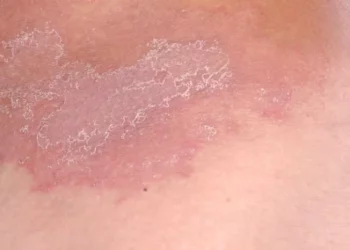Ringworm, despite its name, is not caused by a worm but rather by a fungus that infects the skin. This common skin condition can lead to various symptoms, including red, scaly patches that resemble a ring, but does it also cause blisters? Let’s delve into the details of ringworm, its symptoms, and whether blisters are a typical manifestation of this fungal infection.
What is Ringworm?
Ringworm, medically known as dermatophytosis or tinea corporis, is a fungal infection that affects the skin, scalp, and nails. It is caused by various types of fungi, including those from the Trichophyton, Microsporum, and Epidermophyton genera. Despite its name, ringworm has no relation to worms. The term “ringworm” originated from the appearance of the infection on the skin, where it often forms circular or ring-shaped patches.
Types of Ringworm Infections
Ringworm can affect different areas of the body, each resulting in specific symptoms:
1. Tinea Corporis: This type affects the skin on the body and is characterized by red, scaly patches that can be itchy or inflamed.
2. Tinea Capitis: This affects the scalp and hair, leading to patches of hair loss, scaling, and sometimes swelling of the lymph nodes.
3. Tinea Cruris: Also known as jock itch, this affects the groin and inner thighs, causing redness, itching, and a rash.
4. Tinea Pedis: Commonly known as athlete’s foot, this affects the feet, causing itching, burning, and scaling, particularly between the toes.
5. Tinea Unguium: This affects the nails, causing them to become thick, discolored, and brittle.
Symptoms of Ringworm
The symptoms of ringworm can vary depending on the location and severity of the infection. Common symptoms include:
- Red, scaly patches on the skin
- Itching or burning sensation
- Raised edges that may be inflamed
- Hair loss in affected areas (in the case of scalp ringworm)
- Brittle or discolored nails (in the case of nail ringworm)
Does Ringworm Cause Blisters?
While ringworm typically presents with the aforementioned symptoms, it generally does not cause blisters. Blisters are fluid-filled sacs that form beneath or within the skin due to various causes, such as burns, friction, or infections like herpes simplex virus (HSV) or chickenpox. In the case of ringworm, the primary symptoms are more likely to include red, scaly patches rather than blisters.
Identifying Blisters in Skin Infections
If you are experiencing symptoms that resemble blisters along with a skin infection, it’s essential to consider other potential causes. Blisters can be indicative of other skin conditions or infections, such as:
- Herpes simplex virus (HSV): Causes painful blisters that typically appear in clusters and can recur.
- Impetigo: A bacterial infection that causes honey-colored crusts and fluid-filled blisters.
- Chickenpox (Varicella): A viral infection characterized by itchy blisters that eventually scab over.
Treatment for Ringworm
Ringworm can usually be treated effectively with antifungal medications, which may be applied topically or taken orally depending on the severity and location of the infection. Common antifungal medications include clotrimazole, miconazole, terbinafine, and fluconazole. Additionally, keeping the affected area clean and dry can help prevent the spread of the infection and promote healing.
Prevention of Ringworm
Preventing ringworm involves practicing good hygiene and avoiding contact with infected individuals or contaminated items. Here are some preventive measures:
- Wash hands regularly, especially after touching animals.
- Avoid sharing personal items like towels, clothing, or hairbrushes.
- Keep skin clean and dry, especially in areas prone to sweating.
- Treat pets for fungal infections to prevent transmission.
When to Seek Medical Attention
If you suspect you have ringworm or are experiencing symptoms such as blisters that do not seem consistent with this fungal infection, it’s essential to consult a healthcare professional for an accurate diagnosis and appropriate treatment. In some cases, a skin biopsy or microscopic examination may be necessary to confirm the diagnosis.
Conclusion
In conclusion, ringworm is a common fungal infection of the skin, scalp, or nails caused by various fungi. While it presents with characteristic symptoms like red, scaly patches, it typically does not cause blisters. If you have concerns about skin symptoms, including the presence of blisters, it’s important to seek medical advice for proper diagnosis and treatment. Practicing good hygiene and taking preventive measures can help reduce the risk of ringworm and other skin infections.
Related Topics:


























